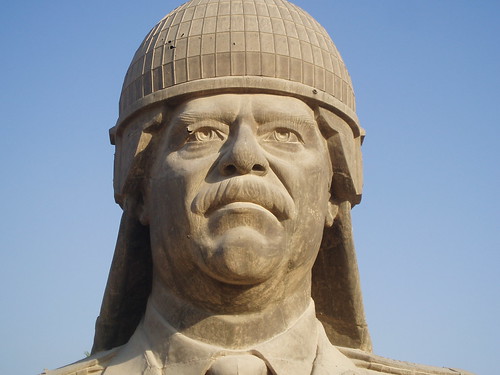
The internal functioning of Saddam Hussein’s Ba’th Party, its relations with Iraq’s military and its resiliency remain poorly understood. However, Joseph Sassoon’s Saddam Hussein’s Ba‘th Party: Inside an Authoritarian Regime sets out to change this. His meticulous study of “liberated” archives – now housed at Stanford University and the University of Colorado – offers a unique insight into Saddam Hussein’s regime that challenges the dominant theories used to explain how he and his party consolidated power.
Rewards and Punishment
From the outset, Sassoon is adamant that the Ba’th Party used rewards and punishment as a strategy to recruit Iraqis into the party apparatus. By 2002, it was estimated that 17% of the population were party members, although the majority of these were in the lower ranks. Their reasons for joining were varied. Whereas some truly believed in the Ba’athist ideology, others were placed under incessant pressure and ideological indoctrination. In return, party members became enmeshed in an intricate system of rewards that ranged from public employment to becoming a “Friend of Saddam Hussein”.
The regime also crafted a systematic punishment policy that used sophisticated tools of state repression, violence and brutal (mass) killings. Those who rejected the invitation to join the party were often monitored and threatened by the security services. Saddam Hussein further mastered the use of state repression thanks to those party members who provided information on individuals, families, and organizations. Accordingly, Sassoon argues that the Ba’ath regime’s efforts to consolidate power cannot be explained by simplistic descriptions of brutality as outlined in Kanan Makiya’s Republic of Fear: The Politics of Modern Iraq. While Makiya should be rightly credited for documenting the horrors of Ba’th regime, his argument rests on shaky foundation because he does not make a careful distinction between tyrannies and totalitarianism.
Tyranny or Totalitarianism?
Sassoon also debunks the widespread belief that Saddam Hussein’s regime was a totalitarian one based on Sunni domination. To support his argument, he calls upon theoretical and empirical evidence from the Soviet era to confirm that the Ba’th Party lacked the qualities of totalitarianism, specifically a centrally planned economy, forced industrialization and powerful bureaucratic institutions to control society. He rightly cites the gulags and command economy as prime examples of forced labor and top-down industrialization in which private and public spheres were absolutely controlled by the Communist Party of the Soviet Union. By contrast, Ba’thism did not have same grip on Iraqi society despite Saddam Hussein’s attempts to have absolute control over the public sphere.
In order to demonstrate this point, it is worth revisiting Hannah Arendt’s fine distinction between tyranny and totalitarianism. While tyrannies tend to dominate public space and political relations, they often leave ‘private life’ intact, thereby giving individuals the opportunity to think and interact with other people. Totalitarian regimes, however, destroy both private and public life by not leaving any public space and using measures such as forced labor to eliminate human interaction. In this vein, while the Ba’ath Party used whole panoply of sophisticated and systematic measures – including public surveillance, indoctrination, and the cult of leadership – it nevertheless left some space for private lives and interaction. It is true that ordinary Iraqis could not travel abroad without prior approval and few Iraqis could work for Western companies. Yet creativity and interaction could not be fully prevented, even if the regime strived for it. Indeed, the 1991 Shi’ite uprisings, the continuous Kurdish struggle and the production of art in Iraq throughout Ba’th years help to further demonstrate this point.
It may also have been the case that Saddam’s constant repression of Iraq’s Shi’ites and Kurds convinced many that the Ba’ath regime was Sunni. However, party archives reveal that many Kurds and Shi’ites were also senior figures in the Ba’ath regime. This demonstrates that loyalty was more important to Saddam Hussein than identity, a fact that became crystal clear after his son-in-law Hussein Kamal al-Majid defected to Jordan in 1996. Sassoon’s analysis also shows that Saddam Hussein personally built an elite network of trusted people to effectively control the Iraqi military in order to prevent a challenge to his regime.
Credit due
Sassoon had to read millions of archived materials, a large amount of which were written in hand, to form a coherent picture of the regime over 35 years and should be credited for his exceptional analysis. Yet, two criticisms are in order. First, Sassoon’s study relies heavily upon party documents and interviews with former Ba’th Party members. Perhaps he could have taken the time to talk to those ordinary Iraqis who were subject to state repression and violence on a daily basis. And, as suggested above, Sassoon’s analysis might also have benefited from deeper philosophical and theoretical research in order to make a more compelling case against those who argue that the Ba’th Party was totalitarian.
Despite these problems, Sassoon’s book is a must read for any student of Middle Eastern politics and it is likely to become a standard text. He undoubtedly challenges the reader to rethink the use of collective violence, state repression, consent creation and delivery of services as tools of survival. In this respect, the arguments made by this book go beyond Iraq and help us to understand why and how Arab authoritarian regimes have survived for so long. The legacy of such regimes is still felt today in the Arab streets despite ongoing efforts to overthrow corrupt leaders and their systems.
Ali Gokpinar is a Fulbright fellow. His research focuses on conflict resolution, peace building, and civil war. He tweets @zynlgkpnr and blogs at aligokpinar.com.
For additional reading on this topic please see:
Make or Break: Iraq’s Sunnis and the State
Iraq: Politics, Governance, and Human Rights
For more information on issues and events that shape our world please visit the ISN’s Weekly Dossiers and Security Watch.

